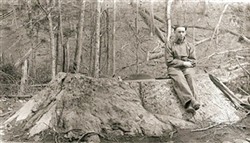Short history of the nation’s most-visited national park
Published in The Ledger, July 31, 2015
 Stump of a large tulip poplar tree cut by Little River Lumber Company on Lynn Camp Prong. Photo by Jim Shelton in 1926.
-- Photograph Courtesy Of The National Park Service Archives
Stump of a large tulip poplar tree cut by Little River Lumber Company on Lynn Camp Prong. Photo by Jim Shelton in 1926.
-- Photograph Courtesy Of The National Park Service Archives
In 1899, the Appalachian National Park Association began discussing the concept for a 12,000-square-mile park in parts of North and South Carolina, Georgia, Virginia and Tennessee.
During the next century, many individuals, organizations, politicians and nature advocates worked to establish what is now the country’s most visited national park – the Great Smoky Mountains.
National Park Service Director Stephen Mather first voiced support for establishing a national park in the East. In 1927, John D. Rockefeller Jr. designated $5 million as a matching gift and challenged officials in Tennessee and North Carolina to raise an equal amount before Rockefeller released the funds. Five years later, the park’s first superintendent – J. Ross Eakin – and his rangers arrived for work.
At first, Eakin and his rangers acted more like sheriffs in the Wild West. Getting control of the lawlessness, particularly running moonshine through Appalachia, poaching wildlife and squatting, was their primary concern in the first few years.
President Franklin D. Roosevelt, who would formally dedicate the park in 1940, issued an executive order pledging over $1.5 million in federal funds to establish the park in 1933. Despite their best efforts, officials in the states of Tennessee and North Carolina did not raise the matching funds required to receive the $5 million pledge from Rockefeller. However, the Rockefeller family agreed to release $500,000, which, combined with the federal funding from Roosevelt, helped the states acquire the lands required for full park status.
During this same year, Roosevelt created the Civilian Conservation Corps (CCC) and, by May, five camps were established in the park, with each camp housing 200 men to build trails, clear areas for campgrounds and manage the park’s natural resources.
In 1934, Congress passed legislation that established the 400,000 acres as a complete park. On June 15, 1934, the Great Smoky Mountains National Park was born.
Over the next five to six years, the park saw an increase in activity from the arrival of the first park naturalist to a wedding in the snow on Clingmans Dome. Roosevelt formally dedicated the park in September of 1940 and spoke from the Rockefeller Memorial at Newfound Gap near the Tennessee-North Carolina border.
In 1941, visitation to the park topped 1 million for the first time, but War World II slowed the influx of visitors and shut down the CCC program.
Camps across the park sat vacant for a couple of years until two groups of conscientious objectors arrived to resume the projects.
Visitation to the park also slowed down during the war because of gasoline rationing. However, after the war, visitation picked back up. By 1949, 1.5 million people visited the park. That number grew to 10 million-plus by 1999.
Invasive species have played a prominent role in the changing landscape of the park. Some consider the invasive fungus, Cryphonectria paracitica, or chestnut blight, to be one of the worst as it decimated 99 percent of the American Chestnut, a tree that at one time had the designation of the dominate tree species in the park.
The chestnut blight, a fungal invader from Asia, infects the tree through wounds and grows beneath the bark, killing the cambium, or tissue of the tree. Cankers form that eventually girdle the tree and kill everything above it. Because the roots are still alive, the tree is not officially dead, but it can no longer grow to the majestic beauty seen by visitors before 1940.
Another destructive visitor to the park is the invasive hemlock wooly adelgid, an aphid native to East Asia that sucks sap from hemlock and spruce trees.
It was first discovered in Virginia in the early 1950s and is now established in 11 states from Georgia to Massachusetts. The mortality rate of hemlock trees has skyrocketed because of this pest, but research scientists in the Smokies have worked to battle the spread of the disease in the park. Today, according to new superintendent Cassius Cash, the ongoing research efforts have helped stave off the destruction of the visiting aphid.
Park rangers and research scientists lead ongoing efforts to reintroduce several species into the park. During the 50th anniversary celebration, four peregrine falcons were released in the park.
A few years later, 10 otters were released near Abrams Creek. In 1991, park officials attempted to re-establish the red wolf in the park, but the high mortality rate of wolf pups deterred any further efforts of re-introduction.
Leave a comment